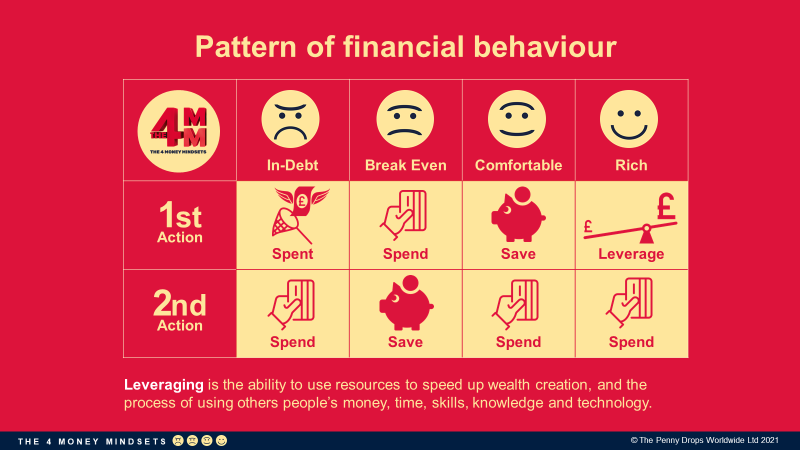DISCOVER YOUR MONEY MINDSET & WHAT TO DO NEXT
There are 4 Money Mindsets , In-Debt, Break-Even, Comfortable & Rich and whichever one you have will dictate how financially successful you are.
VIEW THE MINDSETSWhat is a Mindset?
A mindset is exactly what it suggests: how the mind is ‘set’ (a bit like concrete) on any subject. Mindset can be defined as a habitual mental attitude that determines how you will interpret, decide and ultimately respond to situations whether the mindset is appropriate or not.
A Money Mindset specifically relates to money and produces real results. This means that your Money Mindset produces the financial results in your life.
THE IN-DEBT MONEY MINDSET
Those who habitually run an In-Debt Money Mindset are driven to borrow and spend. They have already spent some or all of their money by the time they get it.
This pattern shows up in their bank statements as money coming in then immediately going out to meet debt commitments such as car loans, bank loans, credit and store card loans or loans from friends or family.
Someone running an In-Debt Money Mindset habitually thinks, feels and says to himself and everyone around him that he hasn’t got enough money. He often finds himself driven by a feeling of ‘not enough’ or lack. In response to this habitual feeling, he often finds himself spending to feel better.
THE BREAK-EVEN MONEY MINDSET
Those who habitually run a Break-even Money Mindset are driven to cover their expenses and spend the rest. People with this mindset prioritize their spending, allocate money and stop spending when the money is gone.
They pay all the fixed expenses first then spend what is left on variable expenses, but do not spend more than they have. They save what is left over for a specific item or purpose. If they run out of money, they stop spending, believing that once it’s gone, it’s gone. They would never take on debt.
The pattern seen in their bank statements is one of running out of money by the end of the payment period.
Some with this mindset are very good at current account budgeting and sometimes budget using the envelope system.
THE COMFORTABLE MONEY MINDSET
Those who habitually run a Comfortable Money Mindset are driven to save. When they get any money, they initially save a proportion and live on the rest. These people often have large savings and could survive for a considerable length of time if their source of income dried up. When they save it’s for the future or a rainy day rather than to buy or invest in something specific.
It is notable than when someone with this mindset invests, they do so not to lose, rather than invest more and work at it to guarantee success. They often say things like: “don’t invest anything you can’t afford to lose.” They also have no system or exit strategy or plan for what to do with their savings, instead just keeping it for a rainy day. Sadly, this attitude often causes them to lose as they don’t recognise when to use their savings to create more or improve their lives. The need to save is a huge driver. They see financial threats everywhere and save to create a buffer between them and the harsh financial world outside. They are masters at delayed gratification, they can tolerate quite a bit of discomfort.
THE RICH MONEY MINDSET
Those who run a Rich Money Mindset habitually focus on adding value and leveraging resources. They see resources all around them, such as time, money, skills or technology, and are driven to leverage them.
Leveraging is devising a way to use a resource so that the input is much less than the output. That is, doing a lot with a little, or creating a big output with a significantly smaller input. People with a Rich Money Mindset understand this is the only way of making yourself rich.
When I asked rich people what someone who is savvy with money would do with fresh funds, they invariably said, buy an asset, add value and Leverage so I make more. Very few people understand the concept of leverage and, as a result, continue to work harder than ever to make ends meet, wondering, “How come the rich get all the luck and we never seem to get ahead?”
IDENTIFY YOUR MONEY MINDSET
Your Money Mindset is clearly identifiable from your financial behaviours - what you actually do with your money.
Your Money Mindset is immediately visible from your financial records i.e. your bank statements.
There is a very specific observable and verifiable financial pattern for each Money Mindset.
Look at your bank statements. Observe what happens with your money as soon as you get it (as soon as it comes in)
Do the bank statements show:
- A portion of it is spent, that is a portion of it is automatically taken to cover consumer debt? and then you spend what's left over, sometimes you may even borrow more?
- You firstly use a portion of it to cover your known expenses, only then will you spend what is left
- You save first - then spend
- As soon as you get some money in you leverage it! then spend
As soon as money comes in, you will demonstrate a sequence of financial behaviours.
There are 4 Money Mindsets, In-Debt, Break-Even, Comfortable & Rich which set of financial behaviours are you currently doing?
You see this clearly from someone’s financial records.
Take a look at your bank statements and see which of the categories you fall into.






